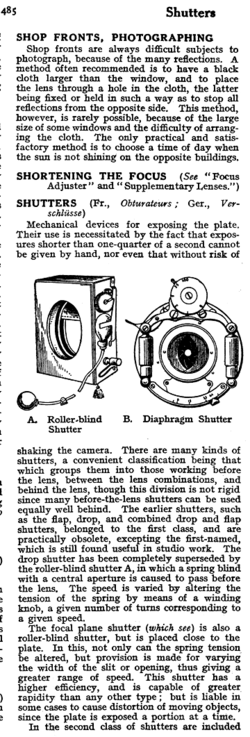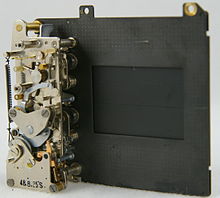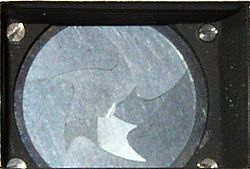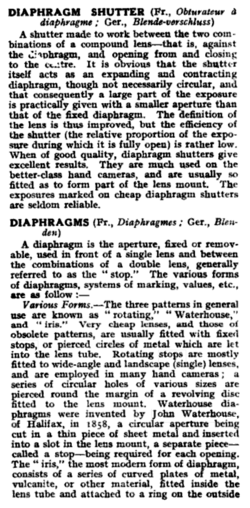- Shutter (photography)
-
In photography, a shutter is a device that allows light to pass for a determined period of time, for the purpose of exposing photographic film or a light-sensitive electronic sensor to light to capture a permanent image of a scene. A shutter can also be used to allow pulses of light to pass outwards, as in a movie projector or signal lamp.
Contents
Camera shutter
Camera shutters can be fitted in two positions:
- Central shutters are mounted within a lens assembly, or more rarely behind or even in front of a lens, and shut off the beam of light where it is narrow. A leaf mechanism is usually used.
- Focal-plane shutters are mounted near the focal plane and move to uncover the film or sensor.
Shutters immediately behind the lens were used in some cameras with limited lens interchangeability. Shutters in front of the lens were used in the early days of photography.
Other mechanisms than the dilating aperture and the sliding curtains have been used; anything which exposes the film to light (for a specified time) will suffice.
The time for which a shutter remains open (exposure time) is determined by a timing mechanism. These were originally mechanical, but since the late twentieth century are mostly electronic.
The exposure time and the effective aperture of the lens must together be such as to allow the right amount of light to reach the film or sensor. Additionally, the exposure time must be suitable to handle any motion of the subject. Usually it must be fast enough to "freeze" rapid motion; sometimes a controlled degree of blur is desired, to give a sensation of movement.
Most shutters generate a flash synchronization switch to trigger a flash, if connected. This was quite a complicated matter with mechanical shutters and flashbulbs which took an appreciable time to reach full brightness, focal-plane shutters making this even more difficult. Special flashbulbs were designed in a slow-burn style where the light would reach full intensity, and then remain at that intensity to wait for the slow focal-plane shutter to expose the full film frame. Many of these problems have been alleviated with modern electronic timers and electronic flash units which fire virtually instantaneously. When using a focal-plane shutter with a flash, a photographer will typically operate the shutter at its X-sync speed or slower; however, some electronic flashes can produce a steady pulse compatible with a focal-plane shutter operated at much higher shutter speeds. Keeping in mind that the focal-plane shutter is still going to impart focal-plane shutter distortions to anything that is moving.
Cinematography uses a rotary disc shutter in movie cameras, a continuously spinning disc which conceals the image with a reflex mirror during the intermittent motion between frame exposure. The disc then spins to an open section that exposes the next frame of film while it is held by the registration pin.
Focal-plane shutter
Main article: Focal-plane shutterFocal-plane shutters are usually implemented as a pair of cloth, metal, or plastic curtains which shield the film from light. For shutter speeds slower than a certain point (known as the X-sync speed of the shutter), which depends on the camera, one curtain of the shutter opens, and the other closes after the correct exposure time. At shutter speeds faster than the X-sync speed, the top curtain of the shutter travels across the focal plane, with the second curtain following behind, so that each section of the film or sensor is exposed for the correct amount of time. The effective exposure time can be much shorter than for central shutters.
Focal plane shutters have the advantages of allowing the use of interchangeable lenses without requiring the expense of a separate shutter for each lens.
They have several disadvantages as well:
- Distortion of fast-moving objects: although no part of the film is exposed for longer than the time set on the dial, one edge of the film is exposed an appreciable time after the other, so that a horizontally moving shutter will, for example, elongate or shorten the image of a car speeding in the same or the opposite direction to the shutter movement.
- Their louder noise which is a detriment to candid photography and nature photography.
- Their more complex mechanical structure causes a shorter life-span than other shutter designs.
- If a focal-plane shutter camera is left with the mirror up and sunlight falls on the face of the lens, it is possible to burn holes in the closed curtain of the shutter, if the sun light is concentrated for a longer period on the shutter.
- Camera shake due to the impact of the larger curtains starting and stopping rapidly. Camera designers have learned to overcome the problem of mirror-slap by including a mirror-lock-up feature in some cameras. This will remove the camera-shake from the large slapping mirror inside the camera but it still does nothing to prevent camera-shake by the shutter mechanism itself. Mirror-lock-up introduces yet another problem, with the mirror locked-up out of the way you can no longer use the optical viewfinder for focussing, framing, or exposure metering. Newer DSLR cameras are now including a "live-view" where the image from the main imaging sensor is displayed directly on an LCD display, so you can still focus (manually or in newer models by contrast detection) and frame, and it prevents most camera shake from the focal-plane shutter, as instead of first curtain an electronic shutter is used.
Leaf shutter
A leaf shutter is a type of camera shutter consisting of a mechanism with one or more pivoting metal leaves which normally does not allow light through the lens onto the film, but which when triggered opens the shutter by moving the leaves to uncover the lens for the required time to make an exposure, then shuts.
Simple leaf shutters have a single leaf, or two leaves, which pivot so as to allow light through to the lens when triggered. If two leaves are used they have curved edges to create a roughly circular aperture. Simple leaf shutters typically have only one shutter speed and are commonly found in disposable cameras. Some have more than one speed. Shutters for newer digital cameras are a combination of electronic and mechanical timings. Some cameras employ a 100% electronic shutter, created by turning on and off the imaging sensor's signals. Digital cameras that can also take video implement this method for their video modes. For single-frame photography then either mechanical or mechanical+electronic methods are used.
Diaphragm shutter
A diaphragm shutter is a type of leaf shutter consisting of a number of thin blades which briefly uncover the camera aperture to make the exposure. The blades slide over each other in a way which creates a circular aperture which enlarges as quickly as possible to uncover the whole lens, stays open for the required time, then closes in the same way.[1] The larger the number of blades, the more accurately circular is the aperture. An odd number of blades is usually used: 3, 5, or more.
The term diaphragm shutter has also been used to describe an optical stop with a slit, near the focal plane of a moving-film high-speed camera.[2]
Central shutter
A central shutter is a camera shutter normally located within the lens assembly where a relatively small opening allows light to cover the entire image. The term is also used for shutters behind, but near to, the lens. The alternative to a central shutter is a focal-plane shutter.
Interchangeable lens cameras with a central shutter within the lens body require that each lens has a shutter built into it. In practice most cameras with interchangeable lenses use a single focal plane shutter in the camera body for all lenses, while cameras with a fixed lens use a central shutter; many medium format cameras and most large format cameras, however, have both interchangeable lenses and use central shutters.
Film cameras, but not digital cameras, with a central shutter and interchangeable lenses often have a secondary shutter or darkslide to cover the film and allow changing lens in mid-roll without fogging the film.
Central shutters usually use either the simple leaf mechanism or the diaphragm mechanism.
The main advantages of the central shutter compared to a focal-plane shutter are:
- Relatively simple construction is possible.
- Less expensive to produce than a focal-plane shutter[citation needed].
- Flash synchronization is possible at all speeds because the shutter opens fully.
- Small size is achieved by placing the shutter where the bundle of rays is smaller, either inside the lens or inside the camera body.
- Many versions have no connection between the cocking mechanism and the film advance mechanism, making multiple exposures possible.
- Generally much quieter operation because of fewer and less bulky moving parts
- More realistic photographs in high speed follow-through—lateral focal plane shutters compress or elongate the image in such cases.
- Longer shutter life.
Some disadvantages of the central shutter are:
- For an interchangeable lens system, each lens has to have a shutter built into it.
- Leaf shutter speeds are limited by the speed at which the leaves can move: normally 1/500th of a second for a diaphragm shutter and 1/125th of a second for a simple leaf shutter.
- Some versions may have no connection between the cocking mechanism and the film advance mechanism, making accidental multiple exposures a common problem, although this is a feature of camera manufacture rather than the shutter itself.
Electronic shutter
Digital image sensors (both CMOS and CCD image sensors) can be constructed to give a shutter equivalent function by transferring many pixel cell charges at one time to a paired shaded double called frame transfer shutter. If the full-frame is transferred at one time, it is a global shutter. Often the shaded cells can independently be read, while the others are again collecting light.[3] Extremely fast shutter operation is possible as there are no moving parts or any serialized data transfers. Global shutter can also be used for videos as a replacement for rotary disc shutters.
Image sensors without a shaded full-frame double must use time-consuming serialized data transfer of illuminated pixels called rolling shutter. It scans parts of an image mostly by line at different times causing motion effects.[4]
Shutter lag
Shutter lag is the time between pressing the shutter release and the camera responding by taking the picture. While this delay was insignificant on most film cameras and some digital cameras, it may be a problem when trying to capture subjects which are moving quickly such as in sports or other action photography. Today, release shutter delay might be less of an issue again due to the release lag becoming faster and faster. Release lag of a Bridge camera like the Pentax X90 is only approximately 0.021 seconds.[5]
Shutter cycle
A shutter cycle is the process of the shutter opening, closing, and resetting to where it is ready to open again. The life-expectancy of a mechanical shutter is often expressed as a number of shutter cycles.
Projector shutter
In movie projection, the shutter admits light from the lamphouse to illuminate the film across to the projection screen. To avoid flicker, a double-bladed rotary disc shutter admits light two times per frame of film. There are also some models which are triple-bladed, and thus admit light three times per frame (see Persistence of vision).
Shutters are also used simply to regulate pulses of light, with no film being used, as in a signal lamp.
See also
References
- ^ Sidney Ray, Scientific Photography and Applied Imaging, Oxford: Focal Press, 1999
- ^ Focal Encyclopedia of Photography, Macmillan, 1957
- ^ Electronic shuttering: Rolling vs Global shutter Motionvideoproducts
- ^ Shutter Operations for CCD and CMOS Image Sensors Kodak (PDF)
- ^ http://www.adorama.com/alc/news/Pentax-unveils-X90-Megazoom-digital-camera
Categories:- Photographic shutters
Wikimedia Foundation. 2010.





